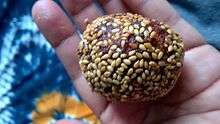Anarsa
An anarsa is an Indian pastry-like snack commonly associated with the Hindu festival of Diwali[1] in Maharashtra and Bihar.[2] Its ingredients include jaggery (unrefined cane sugar), rice, poppy seed and ghee (clarified butter).
 | |
| Course | Dessert |
|---|---|
| Place of origin | India |
| Region or state | Originated in Bihar, Maharashtra |
| Main ingredients | Jaggery, rice, poppy seed, ghee |
Anarsas are made from soaked powdered rice, jaggery or sugar. The rice is soaked in water for three days, with the water changed daily to mitigate fermentation. The rice is then dried, retaining a minimal amount of moisture, and ground into a fine powder. This is known as the pithi, and is mixed with an equal amount of sugar.
This mix can be stored for a long time at room temperature as long as it is sealed in an airtight container to prevent the moisture from soaking the sugar further. A mashed half-inch piece of banana is mixed into the previously prepared dough-balls to help the sugar to dissolve. The resultant dough should be very soft but retain its shape. Small flat discs with about two inches in diameter are formed by flattening a small ball of the dough over a layer of poppy seeds, on one side only. These disks are fried in hot ghee, poppy-coated side first.[3]
The Bihari version tends to be rounder and ball-shaped as opposed to the flatter one in Maharashtra.[4]
Preparation
Anarsas are a pastry-like snack commonly associated with the Hindu festival celebrated for five successive days,[5] and are made from soaked powdered rice, jaggery or sugar. Fry the anarsa in the ghee with the poppy seeds side up on medium flame or else the anarsa will break. Keep on splashing ghee over the upper side of the anarsa with the ladle without disturbing them. Remove the anarsa and drain the ghee by placing the anarsa in an upright position on a flat surface. The poppy-seed side of the anarsa will have a kind of a mesh on it once it is blown. Keep pouring warm oil on the center of the anarsa so that it is uniformly browned.[6]
References
- "दीवाली पर बनती है ये स्पेशल मिठाई".
- Prasad, Lalita; Prasad, Ramakant; Upadhyay, Vijay S (1979). Changing dietary patterns and habits : a socio-cultural study of Bihar (first ed.). Concept. p. 42. Retrieved 19 May 2016.
- "Anarsa in India". India9.com. 23 October 2014. Retrieved 19 June 2015.
- Vikas Khanna (1 December 2012). My Great Indian Cookbook. ISBN 9788184757989.
- "Good Food Secrets: Anarsa". Dicethespice.blogspot.com. 16 June 2012. Retrieved 19 June 2015.
- "Anarsa". Twistoffood.com. 10 September 2014. Retrieved 19 June 2015.